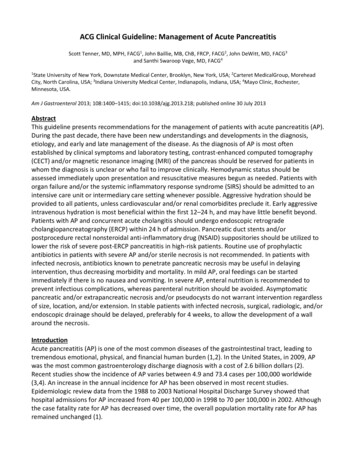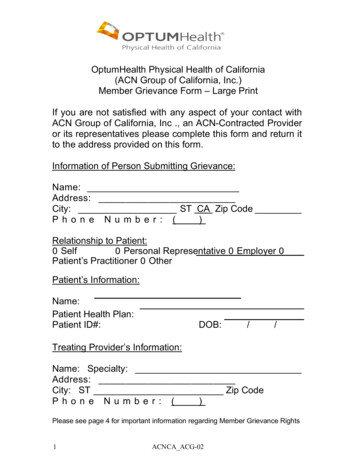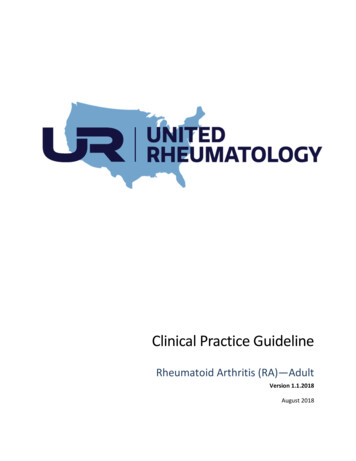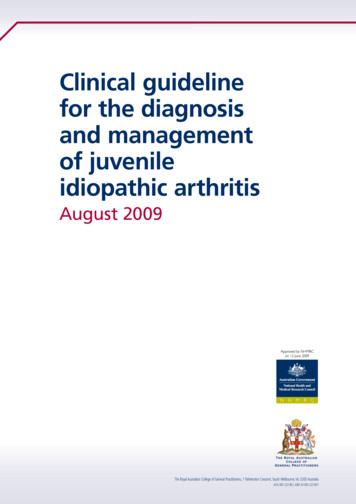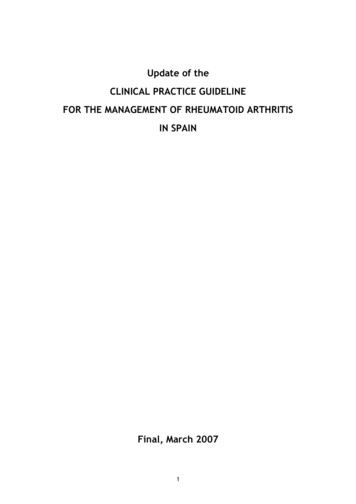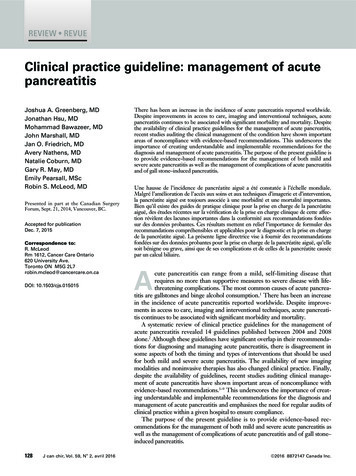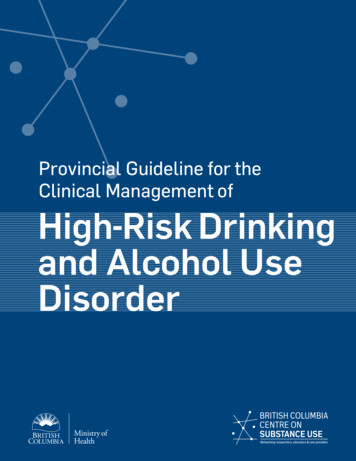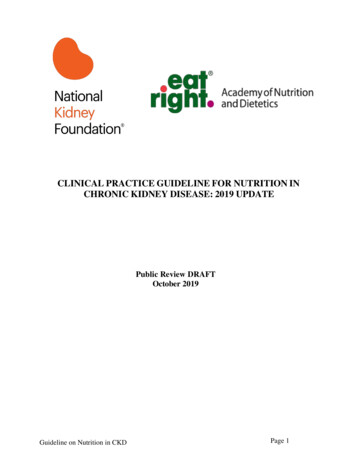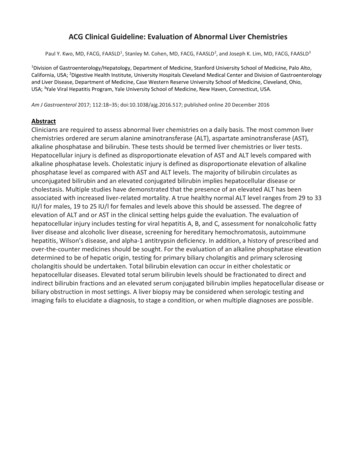
Transcription
ACG Clinical Guideline: Evaluation of Abnormal Liver ChemistriesPaul Y. Kwo, MD, FACG, FAASLD1, Stanley M. Cohen, MD, FACG, FAASLD2, and Joseph K. Lim, MD, FACG, FAASLD31Division of Gastroenterology/Hepatology, Department of Medicine, Stanford University School of Medicine, Palo Alto,California, USA; 2Digestive Health Institute, University Hospitals Cleveland Medical Center and Division of Gastroenterologyand Liver Disease, Department of Medicine, Case Western Reserve University School of Medicine, Cleveland, Ohio,USA; 3Yale Viral Hepatitis Program, Yale University School of Medicine, New Haven, Connecticut, USA.Am J Gastroenterol 2017; 112:18–35; doi:10.1038/ajg.2016.517; published online 20 December 2016AbstractClinicians are required to assess abnormal liver chemistries on a daily basis. The most common liverchemistries ordered are serum alanine aminotransferase (ALT), aspartate aminotransferase (AST),alkaline phosphatase and bilirubin. These tests should be termed liver chemistries or liver tests.Hepatocellular injury is defined as disproportionate elevation of AST and ALT levels compared withalkaline phosphatase levels. Cholestatic injury is defined as disproportionate elevation of alkalinephosphatase level as compared with AST and ALT levels. The majority of bilirubin circulates asunconjugated bilirubin and an elevated conjugated bilirubin implies hepatocellular disease orcholestasis. Multiple studies have demonstrated that the presence of an elevated ALT has beenassociated with increased liver-related mortality. A true healthy normal ALT level ranges from 29 to 33IU/l for males, 19 to 25 IU/l for females and levels above this should be assessed. The degree ofelevation of ALT and or AST in the clinical setting helps guide the evaluation. The evaluation ofhepatocellular injury includes testing for viral hepatitis A, B, and C, assessment for nonalcoholic fattyliver disease and alcoholic liver disease, screening for hereditary hemochromatosis, autoimmunehepatitis, Wilson’s disease, and alpha-1 antitrypsin deficiency. In addition, a history of prescribed andover-the-counter medicines should be sought. For the evaluation of an alkaline phosphatase elevationdetermined to be of hepatic origin, testing for primary biliary cholangitis and primary sclerosingcholangitis should be undertaken. Total bilirubin elevation can occur in either cholestatic orhepatocellular diseases. Elevated total serum bilirubin levels should be fractionated to direct andindirect bilirubin fractions and an elevated serum conjugated bilirubin implies hepatocellular disease orbiliary obstruction in most settings. A liver biopsy may be considered when serologic testing andimaging fails to elucidate a diagnosis, to stage a condition, or when multiple diagnoses are possible.
IntroductionThe authors were invited by the Board of Trustees and Practice Guidelines Committee of the AmericanCollege of Gastroenterology to develop a practice guideline regarding the evaluation of abnormal liverchemistries. We used the following resources:1. A formal review and literature search of the world literature on MEDLINE and EMBASEdatabases dealing with the evaluation of abnormal liver chemistries, studies that dealt withnormal or reference range for alanine aminotransferase (ALT) levels and what thresholdstrigger an evaluation for actionable liver disease. Studies detailing the relationship between ALTand nonalcoholic fatty liver disease, as well as studies assessing the significance of elevatedliver chemistries on overall mortality and morbidity.2. Guideline policies of the American College of Gastroenterology.3. The experience of the authors and independent reviewers, as well as communication withsenior hepatologists across the United States with regard to the threshold for evaluatingabnormal liver chemistries.These recommendations are intended for use by physicians and health care providers and suggestpreferred approaches to the diagnoses and evaluation of those with abnormal liver tests (Table 1).These guidelines are intended to be flexible and should be adjusted as deemed appropriate whenapplied to individual patients. Recommendations are evidence-based where possible. On subjectslacking rigid scientific data, recommendations are made based on the consensus opinion of theauthors. To more fully characterize the available evidence reporting the recommendations, the ACGPractice Guideline Committee has adopted the classification used by the grading of recommendationassessment, development, and evaluation workup with modifications. The strength ofrecommendations are classified as strong or conditional. The quality of evidence supporting strong orweak recommendations are designated by the following level is high, moderate low, or very low quality(1). This is a practice guideline rather than a review article.Liver chemistries that are commonly ordered in comprehensive metabolic profiles are indirect markersof hepatobiliary disease. They are not true measures of hepatic function and thus are best referred toas liver chemistries or liver tests, and should not be referred to as liver function tests. True tests of liverfunction are not commonly performed but include measurement of hepatic substrates that are clearedby hepatic uptake, metabolism, or both processes (2). Because of the widespread use of thecomprehensive metabolic profile testing that is done in routine practice to screen those who presentfor routine evaluation as well as those who are symptomatic and/or referred for elevation of abnormalliver chemistries, such abnormalities require a rational approach to interpretation. To date, there areno controlled trials that have been performed to determine the optimal approach to evaluateabnormal liver chemistries. This guideline has been developed to assist gastroenterologists andprimary care providers in the interpretation of normal and abnormal liver chemistries as well as anapproach to prioritize and evaluate those who present with abnormal liver chemistries.Table 1. Recommendations1. Before initiation of evaluation of abnormal liver chemistries, one should repeat the lab paneland/or perform a clarifying test (e.g., GGT if serum alkaline phosphate is elevated) to confirmthat the liver chemistry is actually abnormal. (Strong recommendation, very low level ofevidence).
2. Testing for chronic hepatitis C is conducted with anti-HCV and confirmation is performedwith HCV-RNA by nucleic acid testing. Risk factors for hepatitis C include history of intranasalor intravenous drug use, tattoos, body piercings, blood transfusions, high risk sexual conduct,and those born between 1945 and 1965. Testing for acute hepatitis C is with anti-HCV andHCV RNA by nucleic acid testing. (Strong recommendation, very low level of evidence).3. Testing for chronic hepatitis B is conducted with HBsAg testing. Testing for acute hepatitis Bis with HBsAg and IgM anti-HBc. The following groups are at highest risk: persons born inendemic or hyperendemic areas (HBsAg prevalence 2%), men who have sex with men,persons who have ever used injection drugs, dialysis patients, HIV-infected individuals,pregnant women, and family members, household members, and sexual contacts of HBVinfected persons. (Strong recommendation, very low level of evidence).4. Testing for acute Hepatitis A (IgM HAV) should occur in patients presenting with acutehepatitis and possible fecal-oral exposure. Testing for acute hepatitis E (IgM HEV) should alsobe considered in those returning from endemic areas and whose tests for acute hepatitis A,B, and C are negative. (Strong recommendation, very low level of evidence).5. Patients with elevated BMI and other features of metabolic syndrome including diabetesmellitus, overweight or obesity, hyperlipidemia, or hypertension with mild elevations of ALTshould undergo screening for NAFLD with ultrasound. (Strong recommendation, very lowlevel of evidence).6. Women consuming more than 140 g per week or men consuming more than 210 g per weekwho present with AST ALT should be considered at risk for alcoholic liver disease and shouldbe counseled for alcohol cessation. (Strong recommendation, very low level of evidence).7. All patients with abnormal liver chemistries in the absence of acute hepatitis should undergotesting for hereditary hemochromatosis with an iron level, transferrin saturation, and serumferritin. HFE gene mutation analysis should be performed in patients with transferrinsaturation 45% and/or elevated serum ferritin. (Strong recommendation, very low level ofevidence).8. Patients with abnormal AST and ALT levels, particularly patients with other autoimmuneconditions, should undergo testing for autoimmune liver disease including ANA, ASMA, andglobulin level. (Strong recommendation, very low level of evidence).9. Patients with persistently elevated AST and ALT levels, especially patients 55 years of age,should undergo screening for Wilson’s disease with serum ceruloplasmin testing. In thesetting of low ceruloplasmin, confirmatory testing with 24-h urinary copper and slit-lamp eyeexamination to identify pathognomonic Kayser–Fleischer rings should occur. (Strongrecommendation, very low level of evidence).10. Patients with persistently elevated AST or ALT should undergo screening for alpha-1 antitrypsin (A1AT) deficiency with alpha-1 anti-trypsin phenotype. (Strong recommendation, verylow level of evidence).11. Physicians should ask patients with abnormal liver chemistries about prescribed and overthe-counter medications, non-prescribed complementary or alternative medicines, anddietary or herbal supplements which may be associated with DILI. (Strong recommendation,very low level of evidence).
12. A liver biopsy may be considered when serologic testing and imaging fails to elucidate adiagnosis, to stage a condition, or when multiple diagnoses are possible. (Strongrecommendation, very low level of evidence).13. An elevation of alkaline phosphatase should be confirmed with an elevation in GGT. Given itslack of specificity for liver disease, GGT should not be used as a screening test for underlyingliver disease in the absence of other abnormal liver chemistries. (Strong recommendation,very low level of evidence).14. Patients with alkaline phosphatase elevation with or without elevation of bilirubin shouldundergo testing for PBC (formerly named primary biliary cirrhosis) with testing for antimitochondrial antibody. (Strong recommendation, very low level of evidence).15 Patients with alkaline phosphatase elevation with or without elevation of bilirubin shouldundergo testing for PSC with MR cholangiography or ERCP in conjunction with IgG4. (Strongrecommendation, very low level of evidence).16 In those with ALT and/or AST levels 5X ULN, the history and laboratory testing should assessfor viral hepatitis B and C, alcoholic and NAFLD, hemochromatosis, Wilson’s disease, alpha-1anti-trypsin deficiency, autoimmune hepatitis and consider drugs/supplement related injury.(Strong recommendation, very low level of evidence).17 In those with ALT and/or AST levels 5–15X ULN, evaluation should also assess for acutehepatitis A, B, and C in addition to all etiologies for AST/ALT elevation less than 5x ULN.(Strong recommendation, very low level of evidence).18 In those with ALT and/or AST levels 15X ULN, or massive elevation ALT of 10,000 IU/l,evaluation should also assess for acetaminophen toxicity and ischemic hepatopathy (shockliver). (Strong recommendation, very low level of evidence).19 A patient presenting with acute hepatitis with an elevated prothrombin time, and/orencephalopathy requires immediate referral to liver specialist. (Strong recommendation, verylow level of evidence).ALT, alanine aminotransferase; ANA, anti-nuclear antibody; ASMA, anti-smooth antibody; AST, aspartateaminotransferase; BMI, body mass index; DILI, drug-induced liver injury; GGT, gamma-glutamyl transferase; HAV,hepatitis A virus; HBc, hepatitis B core antigen; HBsAg, hepatitis B surface antigen; HCV, hepatitis C virus; HEV,hepatitis E virus; HFE, hereditary hemochromatosis; IgM, immunoglobulin M; MR, magnetic resonance; NAFLD, nonalcoholic fatty liver disease; PBC, primary biliary cholangitis; PSC, primary sclerosing cholangitis; ULN, upper limit ofnormal.
What are Truly Normal Liver Chemistry Tests?Summary statements1. A true healthy normal ALT level in prospectively-studied populations without identifiable riskfactors for liver disease ranges from 29-33 IU/L for males and 19-25 IU/L for females, and levelsabove this should be assessed by physicians.2. Elevated ALT or AST above the upper limit of normal (ULN) in a population without identifiable riskfactors is associated with increased liver-related mortality.3. There is a linear relationship between ALT level and body mass index (BMI) that should be assessedby physicians.4. A normal ALT level may not exclude significant liver disease.5. ALT levels are higher in males than females.6. AST and ALT ULN ranges can vary between different labs.7. Clinicians may rely on local lab ULN ranges for alkaline phosphatase and bilirubin.Clinical Assessment of the Patient with Abnormal Liver ChemistriesSummary statementsClinical assessment of the patient with elevated liver tests should begin with a thorough history andphysical examination.1. History should include risk factors for underlying liver disease, associated medical conditions, use ofalcohol, and use of medications including over-the-counter products and herbal supplements.2. Physical examination should assess for stigmata of chronic liver disease, as well as signs orsymptoms pointing to a specific liver disease etiology.Patterns of Liver Chemistry Test ElevationsSummary statements1. Hepatocellular injury is defined as disproportionate elevation of AST and ALT levels as compared tothe alkaline phosphatase level.2. Cholestatic injury is defined as disproportionate elevation in alkaline phosphatase level ascompared to AST and ALT l
Am J Gastroenterol 2017; 112:18–35; doi:10.1038/ajg.2016.517; published online 20 December 2016. Abstract Clinicians are required to assess abnormal liver chemistries on a daily basis. The most common liver chemistries ordered are serum alanine aminotransferase (ALT), aspartate aminotransferase (AST), alkaline phosphatase and bilirubin. These tests should be termed liver chemistries or liver tests.
